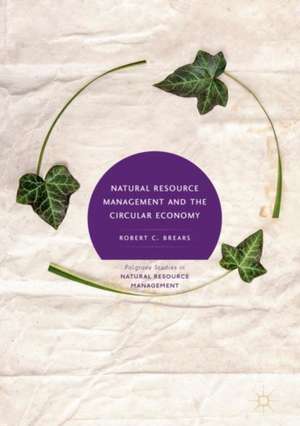Natural Resource Management and the Circular Economy: Palgrave Studies in Natural Resource Management
Autor Robert C. Brearsen Limba Engleză Hardback – 26 feb 2018
Natural Resource Management and the Circular Economy illustrates how governments have promoted the development of an economy that can provide substantial net material savings; mitigate price volatility and supply risks; and improve ecosystem health and long-term resilience of the economy. Through a series of case studies, it details the various innovative policy instruments which can be utilised, including regulations; market-based instruments; incentives; research and innovation support; information exchanges; and support for voluntary approaches. The book also proposes a series of best practices for different countries, both developed and developing, who are implementing their circular economy.
| Toate formatele și edițiile | Preț | Express |
|---|---|---|
| Paperback (1) | 1108.67 lei 6-8 săpt. | |
| Springer International Publishing – 7 iun 2019 | 1108.67 lei 6-8 săpt. | |
| Hardback (1) | 1113.09 lei 6-8 săpt. | |
| Springer International Publishing – 26 feb 2018 | 1113.09 lei 6-8 săpt. |
Preț: 1113.09 lei
Preț vechi: 1357.43 lei
-18% Nou
Puncte Express: 1670
Preț estimativ în valută:
212.98€ • 222.38$ • 176.28£
212.98€ • 222.38$ • 176.28£
Carte tipărită la comandă
Livrare economică 05-19 aprilie
Preluare comenzi: 021 569.72.76
Specificații
ISBN-13: 9783319718873
ISBN-10: 3319718878
Pagini: 421
Ilustrații: XVI, 349 p. 1 illus.
Dimensiuni: 148 x 210 mm
Greutate: 0.57 kg
Ediția:1st ed. 2018
Editura: Springer International Publishing
Colecția Palgrave Macmillan
Seria Palgrave Studies in Natural Resource Management
Locul publicării:Cham, Switzerland
ISBN-10: 3319718878
Pagini: 421
Ilustrații: XVI, 349 p. 1 illus.
Dimensiuni: 148 x 210 mm
Greutate: 0.57 kg
Ediția:1st ed. 2018
Editura: Springer International Publishing
Colecția Palgrave Macmillan
Seria Palgrave Studies in Natural Resource Management
Locul publicării:Cham, Switzerland
Cuprins
1. The Circular Economy .- 2. Circular Economy Fiscal and Non-Fiscal Tools .- 3. Natural Resources Management and the Circular Economy in London .- 4. Natural Resources Management and the Circular Economy in Seattle .- 5. Natural Resources Management and the Circular Economy in Flanders .- 6. Natural Resources Management and the Circular Economy in New South Wales .- 7. Natural Resources Management and the Circular Economy in Denmark .- 8. Natural Resources Management and the Circular Economy in Germany .- 9. Natural Resources Management and the Circular Economy in the Netherlands .- 10. Natural Resources Management and the Circular Economy in Scotland .- 11. Best Practices .- 12. Conclusions.
Notă biografică
Robert C. Brears is the founder of Mitidaption, Mark and Focus, and is a Director on the International Board of the Indo Global Chamber of Commerce, Industries and Agriculture.
Textul de pe ultima copertă
This book provides insight into how governments are using a variety of innovative fiscal and non-fiscal instruments to develop circular economies with significant economic and environmental benefits. It emphasises the urgent need for these circular economies and to move away from our current, linear model that has led to environmental degradation, volatility of resource prices and supply risks from uneven distribution of natural resources.
Natural Resource Management and the Circular Economy illustrates how governments have promoted the development of an economy that can provide substantial net material savings; mitigate price volatility and supply risks; and improve ecosystem health and long-term resilience of the economy. Through a series of case studies, it details the various innovative policy instruments which can be utilised, including regulations; market-based instruments; incentives; research and innovation support; information exchanges; and support for voluntary approaches. The book also proposes a series of best practices for different countries, both developed and developed, who are implementing their circular economy.
Natural Resource Management and the Circular Economy illustrates how governments have promoted the development of an economy that can provide substantial net material savings; mitigate price volatility and supply risks; and improve ecosystem health and long-term resilience of the economy. Through a series of case studies, it details the various innovative policy instruments which can be utilised, including regulations; market-based instruments; incentives; research and innovation support; information exchanges; and support for voluntary approaches. The book also proposes a series of best practices for different countries, both developed and developed, who are implementing their circular economy.
Caracteristici
Provides an overview of the circular economy and the challenges faced by the current linear economic model based on ‘take-make-consume-dispose’. Uses mini-case examples of policies implemented around the world to illustrate the various fiscal and non-fiscal tools available for the development of the circular economy Identifies a series of best practices for the development of a circular economy and encourage a life-cycle perspective on consumption of resources





